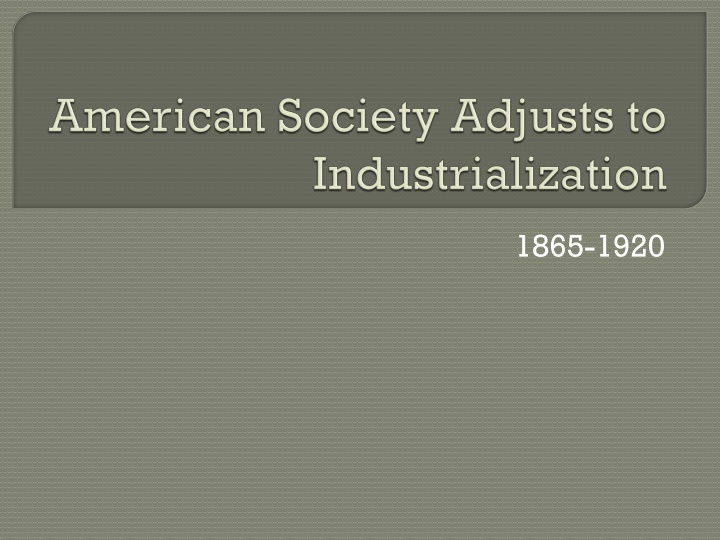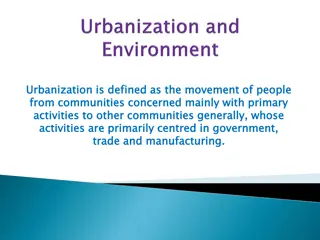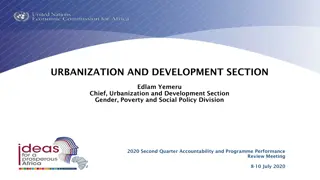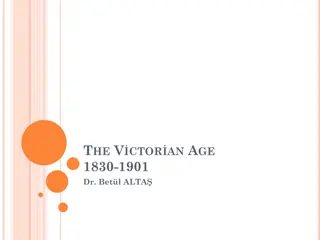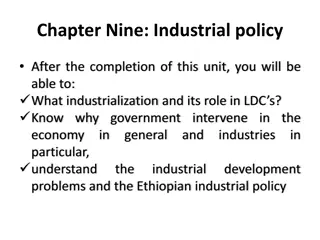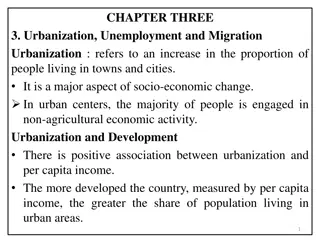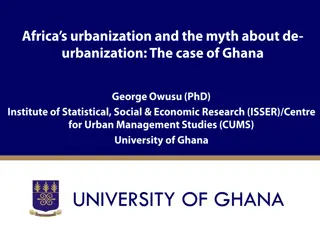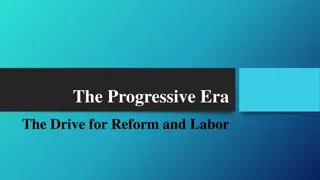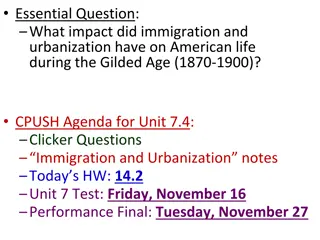The Impact of Industrialization and Urbanization on American Society
Industrialization and urbanization during the late 1800s to early 1900s brought significant changes to American society. The development of a prosperous middle class, influx of immigrants from Europe, and increased participation of women in the workforce were key aspects. The shift from rural to urban living led to both positive and negative effects, with crowded and unhealthy living conditions for workers being among the challenges faced. The growth of cities went hand in hand with the expansion of factories and the movement of workers seeking job opportunities.
Download Presentation

Please find below an Image/Link to download the presentation.
The content on the website is provided AS IS for your information and personal use only. It may not be sold, licensed, or shared on other websites without obtaining consent from the author.If you encounter any issues during the download, it is possible that the publisher has removed the file from their server.
You are allowed to download the files provided on this website for personal or commercial use, subject to the condition that they are used lawfully. All files are the property of their respective owners.
The content on the website is provided AS IS for your information and personal use only. It may not be sold, licensed, or shared on other websites without obtaining consent from the author.
E N D
Presentation Transcript
How did Industrialization and Urbanization affect American society, and culture?
Industrialization and urbanization changed the United States dramatically. During the late 1800s a prosperous middle-class developed Cities became crowded and workers lived in unhealthful conditions Immigrants from southern and eastern Europe arrived in large numbers Women entered the workforce in large numbers
Industrialization and urbanization, or growth of cities, went hand in hand. Cities offered large numbers of workers for new factories Cities provided transportation for raw materials and manufactured goods, as well as markets for the consumption of finished products As more factories were built, more workers, both native-born and immigrant, moved to cities seeking jobs
In 1880, about a quarter of Americans lived in urban areas By 1900, that number had grown to roughly 40 percent By 1920, more than half of all Americans lived in cities. The shift from urban to rural had both positive and negative effects.
1. According to the graph, which was the first year in which more Americans lived in urban areas than in rural areas? 1 1860 2 1890 3 1920 4 1930
2. What was a major cause of the trend shown in the chart? 1 availability of cheap farmland 2 increased industrialization 3 end of restrictions on immigration 4 completion of the interstate highway system
Some of the negative effects of urbanization included crowded, unsanitary living conditions for workers, as well as corrupt municipal, or city, politics.
Construction of decent housing often lagged behind the growth of city populations Much city housing consisted of multifamily buildings called tenements Immigrants and working-class families, who could afford to pay little for rent crowded into such buildings These poorly maintained tenements deteriorated and whole neighborhoods became slums Crime flourished in such poor, congested neighborhoods
Urban crowding helped to spread diseases such as cholera, tuberculosis, and diphtheria Water and sanitation facilities were often inadequate Poor families could not afford proper diets and health care
Political machines, such as New York City s Tammany Hall, took control of many city governments, partly by providing help to the growing number of poor immigrant voters and thereby gaining their support Corruption increased and money that could have been spent on public works often ended up in private pockets
Urbanization was aided by new technologies in transportation, architecture, utilities, and sanitation. In addition, cities offered new cultural opportunities.
Daily thousands who cross it will consider it a sort of natural and inevitable phenomenon such as the rising and setting of the sun and they will unconsciously overlook the preliminary difficulties surmounted before the structure spanned the stream and will perhaps undervalue the indomitable courage, the absolute faith, the consummate genius which assured the engineer s triumph. The Brooklyn Eagle
Builders turned to new technologies to meet the challenge posed by huge numbers of people living together Subways, elevated trains, and streetcars provided mass transportation Steel girders and elevators made possible suspension bridges, such as the Brooklyn Bridge, and high-rise skyscrapers, such as New York City s Flatiron Building Gas and electric lights brightened the streets, making cities safer Growing health problems forced officials to design and build new water and sewage systems
Public and private money funded new museums, concert-halls, theaters, and parks New printing presses turned out mass-circulation newspapers, magazines, and popular novels by authors such as Mark Twain and Horatio Alger Public schools experienced an increased enrollment Reformers, including the philosopher and educator John Dewey, improved the quality of teaching
Many middle-class urban dwellers founded organizations to correct the problems of society In Chicago, Jane Addams started Hull House, a model project that led a settlement house movement to provide education and services to the poor Political reformers sought to unseat corrupt political machines and see public money was spent on improved city services such as police and fire departments and new hospitals, rather than on graft.
Workers and the Poor The Middle Class TheWealthy As a result of industrialization, doctors, lawyers, office workers and skilled laborers made up a growing middle class Neighborhoods offered more spacious, better maintained housing Had both money and leisure time Homes contained the new consumer goods that became available (sewing machines, phonographs) They could afford to go to concerts, sporting events and save money for children's higher education The largest group Most immigrants belonged to this group Lived in slums and poorer neighborhoods (conditions were worse than the company towns) Often workers lacked the time and money to go to theaters or museums or use other resources that cities provide Usually made the city their chief residence, although they often had summer estates outside it The rich made up the smallest segment of urban society They lived in large mansions or elegant apartment buildings Often contributed to charities and cultural institutions such as the opera companies and libraries They could enjoy the broadest range of benefits of city life
The United States has always been a nation of immigrants After the Civil War, however, industrialization drew an even greater flood of immigrants From 1865 to 1900, some 13.5 million people arrived from abroad During much of nineteenth century, there were few restrictions on immigration as the growing numbers of factories provided job opportunities for cheap labor Not until 1920s would the number begin to dwindle Immigration to the United States can be divided into three stages
Colonial Immigration Old Immigration New Immigration
Colonial Immigrants Reasons for Immigration Areas of Settlement Difficulties they Faced Contributions Mostly from England, however also Scotch-Irish, German, Swedish, and Dutch Large number of Africans were also part of the colonial immigration Some came seeking political and religious freedom Others sought to improve their economic standing and their way of life Africans came unwillingly, as slaves English settlement spread along the Atlantic Coast from Maine to Georgia and inland to the Appalachians Within this area, other ethnic groups became concentrated in certain regions Ex. Dutch settled in NY & NJ Immigrants came into conflict with the Native Americans They also had to overcome the challenge of building homes, farms and a new way of life in an unfamiliar region Established a culture much like one they had left in Europe,yet heavily influenced by the geographic factors they encountered in North American Brought over language, government, religions, family and cultural traditions and economic patterns Built a successful economy in North America
Reasons for Immigration Areas of Settlement Difficulties they Faced Contributions Massive famine caused by failure of the potato crop drove millions of Irish immigrants to seek opportunity in the US Revolution in Germany caused many immigrants to seek peace and stability in America Many people continued to arrive in search of better economic opportunity The Irish largely settled in cities in the Northeast Some Germans also stayed in cities, but many moved west to start farms, as did a large number of Scandinavian immigrants Irish and German Catholic immigrants often faced hostility on their arrival in the US Some Americans feared economic competition from the newcomers Since at this time the nation was predominantly Protestant, resentment toward Catholics and Jews were also strong Irish Workers helped build railroads and canals and labored in factories Germans and Scandinavians brought, among other things, advanced farming techniques and new ideas on education such as kindergarten
Reasons for Immigration Areas of Settlement Difficulties they Faced Contributions Adjusting to life in the US could cause strains in immigrant families. At schools, immigrant children learned not only English but American tastes and customs, fearing immigrant parents The growing number of new immigrants produced reactions of fear and hostility among native-born Americans They faced discrimination in jobs and housing Popular pressure to limit immigration increased, political party bosses often arranged assistance for newly arriving immigrants and in return expected political support Hope of greater economic opportunity prompted many of these immigrants to come to America Some also came seeking political freedom Other groups, such as Russian Jews, sought religious freedom Most of the new immigrants settled in cities, especially industrial centers and ports, and were concentrated in ghettos, or urban areas (usually poor) that are dominated by a single ethnic group EX. Asian immigrants tended to settle on the west coast, usually in California The new immigrants found an abundance of jobs in the nations expanding industries, yet because of the steady stream of immigrants workers, wages were low Young Italian and Jewish girls worked in sweatshops of the garment industry Poles and Slavs labored in the coal mines and steel mills Chinese workers helped build the transcontinental railroad They aided America s economic expansion and contributed to the nation s rich culture
The flood of immigration in the late 1800s brought with it a new wave of nativism, the belief that native-born Americans and their ways of life were superior to immigrants and their ways of life In the late 1800s, descendants of the old immigrants were often among the nativists protesting the arrival of new immigrants
Nativists believed that immigrant languages, religions and traditions would have a negative impact on American society Nativist workers believed that the many new immigrants competing for jobs kept wages low A series of downturns in the economy added to fears that immigrants would take jobs from native-born Americans Immigrants thus often met with prejudice and discrimination, jokes and stereotypes about the newcomers were common Nativists also tried to influence legislation against immigrants
Know-Nothing Party: The partys members worked during the 1850s to limit the voting strength of immigrants, keep Catholics out of public office and require a lengthy residence before citizenship. Also known as the American party, the Know-Nothing party achieved none of these goals and died out by the late 1850s Chinese Exclusion Act of 1882: Some native-born Americans labeled immigration from Asia a yellow peril. Under pressure from California, which had already barred the Chinese from owning property or working at certain jobs, Congress passed this law sharply limiting Chinese immigration Gentlemen s Agreement : In 1907 President Roosevelt reached an informal agreement with Japan under which the nation halted the emigrations if its people to the US LiteracyTests: In 1917 Congress enacted a law barring any immigrant who could not read or write Emergency Quota Act of 1921: This law sharply limited the number of immigrants to the US each year to about 350,000 National Origins Act of 1924: This law further reduced and biased it in favor of those from northern and western Europe
People from various cultures have met in the US to form a new American culture. The contributions of individual groups are not easily distinguished. The resulting culture is more important than its parts. Immigrants disappear into an already established American culture. They gave up older languages and customs and became Americanized, adopting the appearances and attitudes of the larger society in order to be accepted. Immigrants from Africa and Asia who looked least like nativist Americans, had the hardest time becoming assimilated Groups do not always lose their distinctive characters. They can live side by side, with each group contributing in different ways to society. This approach is sometimes called the salad bowl theory since groups, like different vegetables in a salad, remain identifiable but create a new, larger whole. Pluralism Melting Pot Theory Assimilation
The immigration Act of 1924 and the National Origins Act of 1924 had established immigration quotas that discriminated against people from outside Western Europe. The act set a quota of about 150,000 people annually. It discriminated against southern and eastern Europeans and barred Asians completely The Immigration Act of 1965, part of President Johnsons Great Society, opened the door for many non-European immigrants to settle in the United States by ending quotas based on nationality.
In an effort to cut down on the number of undocumented workers living in the United States, Congress passed the 1986 Immigration Reform and Control Act, which forbade employers from hiring illegal immigrants This new legislation did not solve the problem of thousands of people who enter the US illegally every year. These immigrants often work in sweatshops type factories, live in substandard housing, and are paid very low wages.
The Bush administration had to deal with several issues relating to immigration, some of which became more serious after the attacks of 9/11. The Real ID Act of 2005 strengthened security requirements at U.S. borders and gave the director of Homeland Security additional powers. Several proposals were introduced in both houses of Congress to increase border patrols and protection, restrict illegal immigration, and strengthen anti-terrorism laws. It is estimated that illegal immigrants in the U.S. today number more than ten million
If current trends continue, it is projected that the population of the U.S. will grow increasingly diverse over the next half century. More of the newest immigrants to the U.S. come from Asian and Latin American countries, compared with earlier waves of immigration that came from Europe
